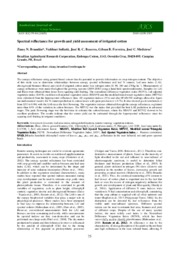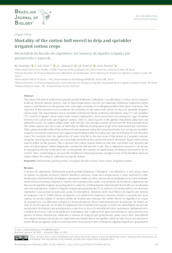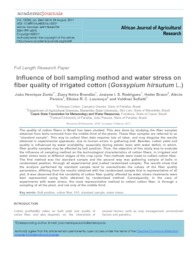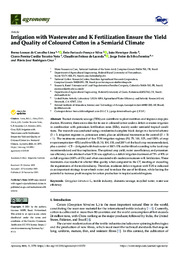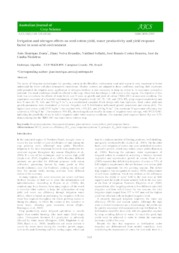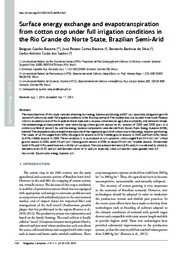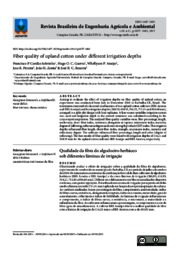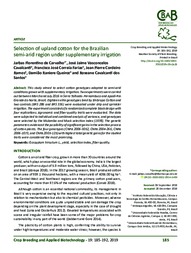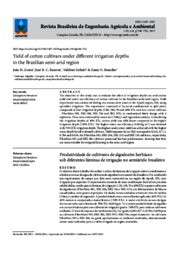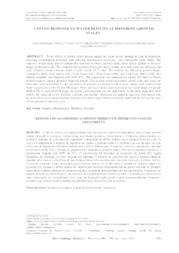Search Publications
Filter by:
| Author(s): BRANDAO, Z. N.; SOFIATTI, V.; BEZERRA, J. R. C.; FERREIRA, G. B.; MEDEIROS, J. C. The canopy reflectance using ground-based sensors has the potential to provide information on crop nitrogen content. The objective of this study was to determine relationships between canopy spectral... ... |
| Author(s): FAUSTINO, R. F.; SILVA, C. A. D. da; ZANÚNCIO, J. C.; PEREIRA, J. R.; PEREIRA, A. I. A. The cotton boll weevil, Anthonomus grandis grandis Boheman (Coleoptera: Curculionidae), is a key cotton crop pest in Brazil. Adverse climatic factors, such as high temperatures and low soil moisture,... ... |
| Author(s): ZONTA, J. H.; BRANDAO, Z. N.; RODRIGUES, J. I. S.; BRAUN. H.; PEREIRA, A.; LOURENÇO, E. R. C.; SOFIATTI, V. The quality of cotton fibers in Brazil has been studied. This was done by studying the fiber samples obtained from bolls removed from the middle third of the plants. These fiber samples are referred t... ... |
| Author(s): LIMA, B. L. de C.; SILVA, Ê. F. de F. e; ZONTA, J. H.; CORDÃO TERCEIRO NETO, C. P.; LACERDA, C. F. de; FERREIRA, J. F. da S.; CRUZ, F. J. R. Treated domestic sewage (TDS) can contribute to plant nutrition and improve crop production. However, there are no data for its use in coloured cotton under a deficit or excess irrigation in combinati... ... |
| Author(s): ZONTA, J. H.; BRANDAO, Z. N.; SOFIATTI, V.; BEZERRA, J. R. C.; MEDEIROS, J. da C. The study of irrigation technologies for growing cotton in the Brazilian northeastern semi-arid region is very important to better understand the water-soil-plant-atmosphere interactions. Modern varie... ... |
| Author(s): BEZERRA, B. G.; BEZERRA, J. R. C.; SILVA, B. B. DA; SANTOS, C. A. C. DOS The main objectives of this study were documenting how energy balance partitioning and ET vary seasonally along each growth season of cotton crop under full irrigation conditions in the Brazilian semi... ... |
| Author(s): CORDÃO SOBRINHO, F. P.; GUERRA, H. O. C.; ARAÚJO, W. P.; PEREIRA, J. R.; ZONTA, J. H.; BEZERRA, J. R. C. Aiming to evaluate the effect of irrigation depths on fiber quality of upland cotton, an experiment was conducted from July to December 2010 in Barbalha-CE, Brazil. The treatments consisted of a facto... ... |
| Author(s): CARVALHO, J. F. de; CAVALCANTI, J. J. V.; FARIAS, F. J. C.; RAMOS, J. P. C.; QUEIROZ, D. R.; SANTOS, R. C. dos This study aimed to select cotton genotypes adapted to semi-arid conditions grown with supplementary irrigation. Two experiments were carried out between March and July 2016 in Serra Talhada- Pernambu... ... |
| Author(s): ZONTA, J. H.; BEZERRA, J. R. C.; SOFIATTI, V.; BRANDAO, Z. N. The objective of this study was to evaluate the effect of irrigation depths on seed cotton yield and water-use efficiency of cotton cultivars in the Brazilian semi-arid region. Field experiment was co... ... |
| Author(s): ZONTA, J. H.; BRANDAO, Z. N.; RODRIGUES, J. I. da S.; SOFIATTI, V. Water deficit at certain cotton growth stages can cause severe damage to crop development, affecting physiological processes and reducing reproductive structures, with consequent yield losses. The obj... ... |
Observation
Some of Embrapa's publications are published as ePub files. To read them, use or download one of the following free software options to your computer or mobile device. Android: Google Play Books; IOS: iBooks; Windows and Linux: Calibre.
Access other publications
Access the Agricultural Research Database (BDPA) to consult Embrapa's full library collection and records.
Visit Embrapa Bookstore to purchase books and other publications sold by Embrapa.

